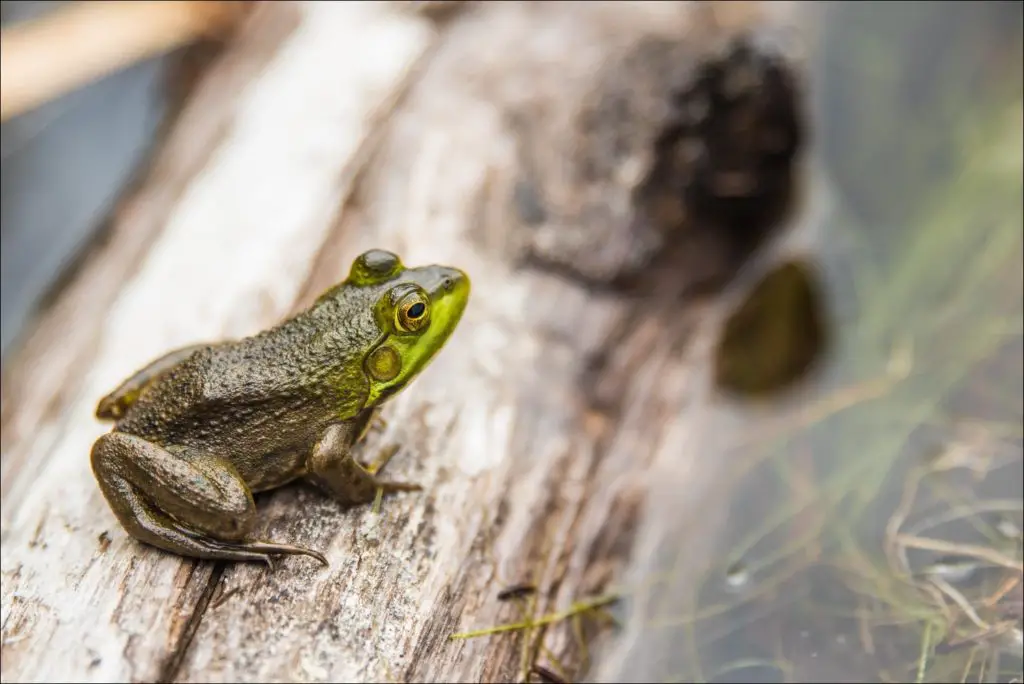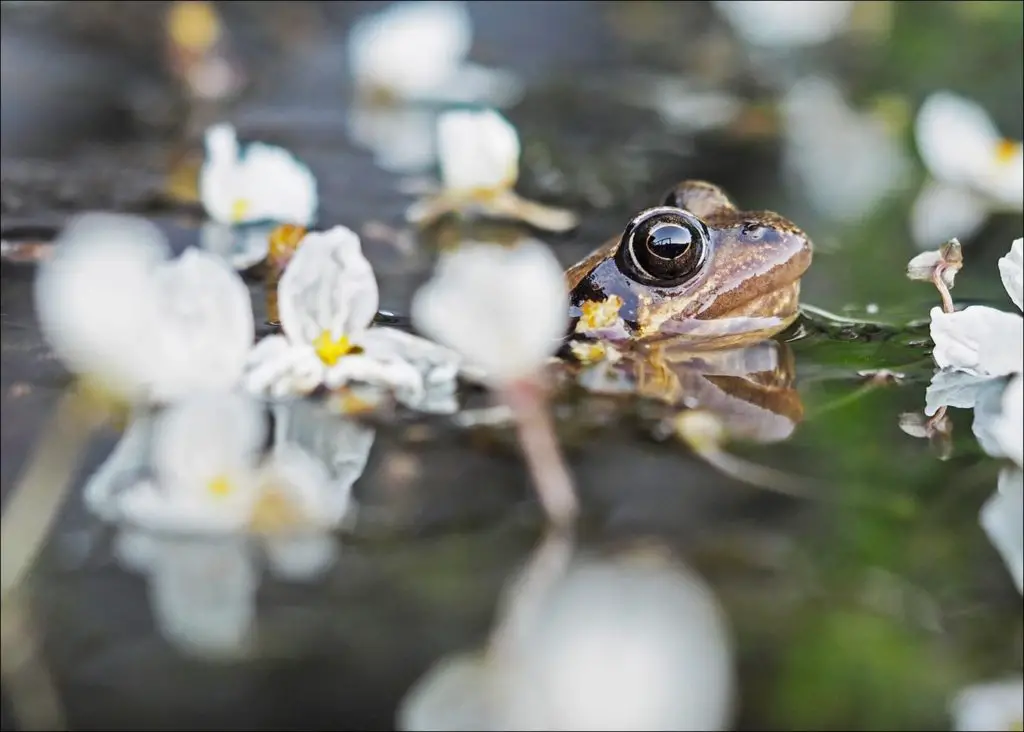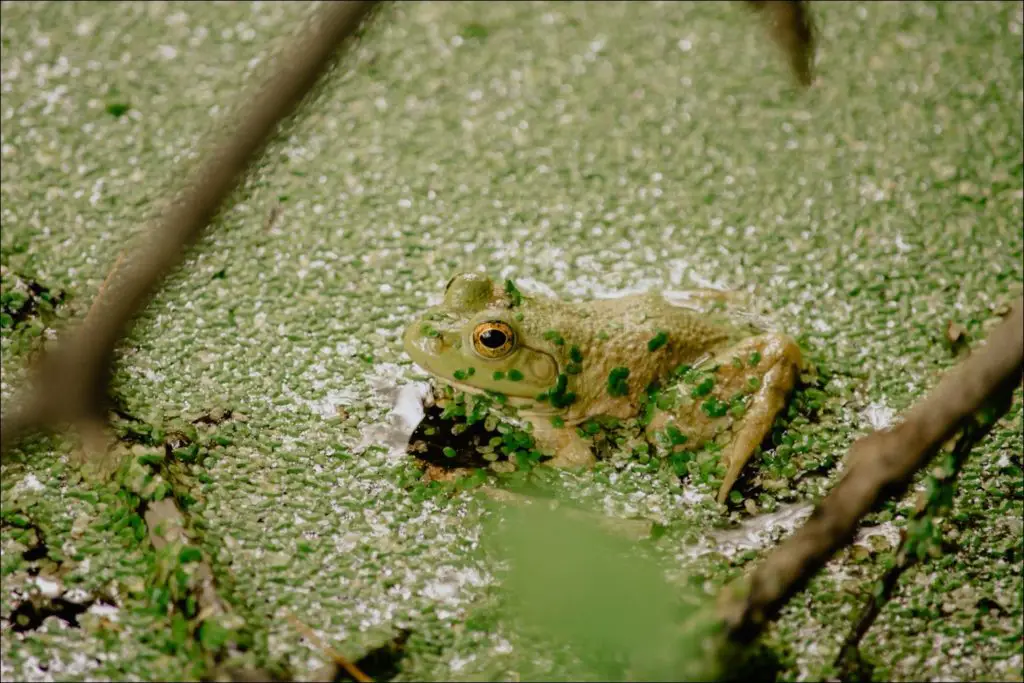During spring, you might spot some frogs near your local ponds or in other damp spots. They have been hibernating and are now ready to go to the ponds and find a partner and breed. That’s when you hear the male frogs performing a concert to impress female frogs.
They might feel a bit hungry after all that singing, and you might wonder what frogs eat and if you can give them some leftovers?
Frogs do not eat human food. Frogs are carnivores, and their primary food is a variety between butterflies, caterpillars, crayfish, flies, moths, slugs, snails, and spiders, depending on the size of the frog. However, baby frogs (tadpoles) consume algae.
All adult frogs need a variety in their diet. The diet should contain fresh insects. In some species where the frogs are more prominent, they usually need vertebrates as well. (Small pink mice). Even fresh fish is also part of their diet.

What can I feed the wild frogs in my garden?
Because frogs are carnivores, they prefer other animals as their prey. Depending on the frog’s size, you can feed them different things. Although, you shouldn’t expect a frog to eat something larger than the space between its eyes. If you have some dead flies, spiders, or something else in the wind sill, that’s a perfect snack for them. However, they enjoy live feed the most for in which case I would suggest crickets or butterflies.
Instead of being forced to hunt yourself, you can always visit the local pet store and find some proper frog food. There are usually are locusts, grasshoppers, crickets, mealworms, and fruit flies available. However, beware frogs are at risk for obesity when being overfed since some species eat until there’s nothing left. Tadpoles, though, need food daily, and pellet food is a simple and cheap way to make sure they stay in good health.
As for drinks, frogs are happy with de-chlorinated water or tap water as long as it doesn’t contain chlorine. Frogs employ a mechanism of osmosis when drinking, which means they drink through their skin. For this purpose, they have a patch on their lower abdomen for absorption of water.
What should I never feed the wild frogs in my garden?
As mentioned earlier, frogs are carnivores and don’t consume vegetables and fruits. So I would advise you not to implement it in their diet. Although in their early stage of life, they are tadpoles and consume algae. In that case, I would suggest you could give them some good nutritious pellet food in their water. You shouldn’t give the frogs any human food animal products like beef, pork, lamb, etc. This is not included in their natural diet and causes them to be poisoned and not nutritionally beneficial. You can try to give the frogs a small amount of frozen fish, but remember, the serving size shouldn’t be bigger than the space between the frog’s eyes.
Can frogs eat fruits and veggies?
Frogs are carnivores and should not eat fruit and veggies in their adult life. Try instead of feeding them insects or larva once a day. Frogs like variety in their food, so a good rotation is important to keep the frog happy.

What should I do with a frog in my garden?
Frogs are a great companions in the garden and help you to remove insects ruining your flowers and vegetable patch. Avoid having any interaction with the frogs (don’t lift them) since they have sensitive skin. Your warm oily hand can both irritate the skin and also be very stressful for the frog. If you have a dog, you might want to keep it away since they also increase stress for the frog.
Benefits of having frogs in your garden
Having frogs in your garden can provide a number of benefits for both your plants and for the ecosystem as a whole. Frogs can help control pest populations by eating insects that can damage your plants, and they can also contribute to soil health by adding nutrients and increasing microbial activity. In addition, frogs can help pollinate flowers and disperse plant seeds, helping to promote the growth and reproduction of your plants. If you’re interested in learning more about the specific ways in which frogs help plants, you might want to check out our article “How Frogs Help Plants.” By creating a frog-friendly garden, you can not only support the health and survival of your plants, but also contribute to the overall health and well-being of the ecosystem.
Can I build something for the frogs?
If you wish to help the frog in your garden, there are many ways to do so. The main thing you can do is to build a pond and build an excellent habitat for them. The pond gives life to frogs and many other amphibians since all amphibian life starts underwater. Build the pond in a shady place which helps stops algal growth and hinders the plants from going out of control. Make sure to have vertical sides so it easy for them to get up again. Adding stones and logs makes it easier for them to climb over. It’s also important to have variations of levels in the pond. Some corner where it is more shallow for future frog spawn. At another end where it’s deeper can the male frog hibernate during winter.
Make sure to decorate with native local plants so the frogs feels familiar with the surroundings.
Build a hibernaculum for the frogs in your garden
Another thing that is very appreciated both among frogs and other amphibians is a hibernaculum. It’s effortless to build and support them with a stress-free place to hibernate.
Build a refuge for the frogs in your garden
Another simple thing to do is to build a refuge. You can easily build one by stacking both logs and sticks on top of each other. The frogs will crawl inside the cracks and rest there during the day until nightfall, when they go out hunting for bugs.
Build a compost heap for the frogs in your garden
Frogs and other amphibians animals love things that retain heat. A straightforward way to make your friends happy is to build a compost heap. The rotting vegetation makes it ideal for them, and different layers are perfect for various amphibians to share the pile.
Design it first, then do
Make sure to plan out your design before you start so you can make it as beneficial for both the frogs and yourself as possible. When the frogs head out at night, make it easy for them to go to a place where they can find many insects.

Conslusion
- You can’t feed human food to frogs unless it’s frozen fish, and it is in tiny portions and not served regularly.
- Food given to frogs shouldn’t be larger than the space between their eyes.
- Building a pond for your garden is a great way to have biodiversity and receive help in the garden with insect control.
- While frogs are carnivorous and don’t eat vegetables and fruit, their babies (tadpoles) aren’t and benefit from a vegetarian complementary pellet that soaks up in the pond.
